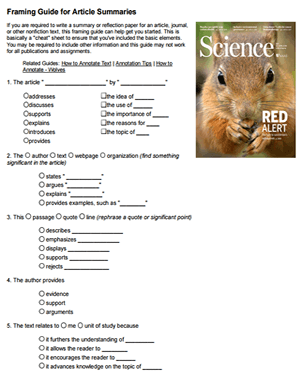
How often do you want to share a good science article with your students? Almost every day I see something in the news related to genetics, ecology, and conservation and encourage my students to learn about current events in science. I often print out articles to have students read and discuss in class.
Getting students to read the articles and engage in a meaningful way can be challenging. I don’t always have the time to write questions to go with an article and when I do, find that many students just copy the answers from friends.
I now have my students write article summaries when they are assigned this extra reading. Since these summaries don’t follow traditional essays that they might have experienced in English class, I start by providing this framing guide that sets up the basic format for summarizing the article.
It’s a quick cheat sheet for beginners and over time my students learn to write summaries without the crutch. I’ve also found that summarizing texts leads to a more in-depth understanding of the concepts presenting in the article.
Generally, the summaries are 2-3 paragraphs long and impossible to copy from friends.
CCSS.ELA-LITERACY.RST.9-10.2 Determine the central ideas or conclusions of a text; trace the text’s explanation or depiction of a complex process, phenomenon, or concept; provide an accurate summary of the text.
CCSS.ELA-Literacy.W.9-10.1 Write arguments to support claims in an analysis of substantive topics or texts, using valid reasoning and relevant and sufficient evidence.
Sources for Science Articles:
Scientific American | Science Friday at NPR | ScienceMag.org
Reuters Science | Nature: Science Journals | Science Daily

